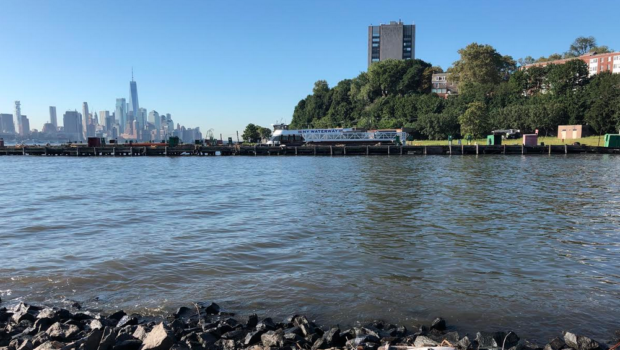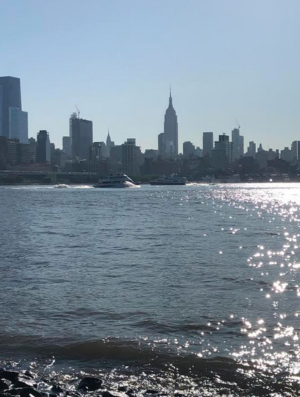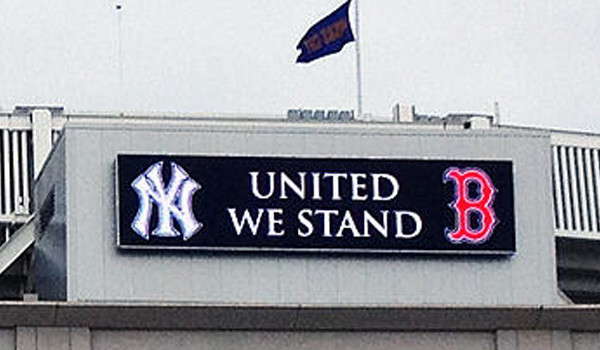
TAKING THE BEACH: Hoboken to See if Eminent Domain Holds Water in Dockyard Fight with NY Waterway
At tonight’s City Council meeting, Hoboken will determine whether or not the City will proceed with eminent domain in its ongoing battle with NY Waterway over the use of Union Dry Dock.
Following the initial vote on August 7 in favor of seizing the land, tonight’s second reading will finalize the City’s plans as they seek to create a contiguous public waterfront. NY Waterway purchased Union Dry Dock in November of 2017, with the hopes of converting the longtime maritime repair facility into a ferry fueling and service dock.
 The 3.15-acre parcel of land known as Union Dry Dock & Repair Company—the last functioning maritime business on Hoboken’s once-bustling industrial waterfront—had been on and off the selling block since 2000.
The 3.15-acre parcel of land known as Union Dry Dock & Repair Company—the last functioning maritime business on Hoboken’s once-bustling industrial waterfront—had been on and off the selling block since 2000.
In 2001, Stevens Institute of Technology planned to construct a soccer field on the site. In 2005, there was a $15 million contract for the property, but the buyer reportedly backed out. In 2009, a developer hoped to build residential towers on the land, but local zoning didn’t permit it. And in 2012, New Jersey Transit initially considered obtaining the land for NY Waterway’s ferry maintenance and refueling.
Hoboken advocacy group Fund For A Better Waterfront had long been urging the City to act on obtaining the property. In October of 2017, the City of Hoboken reached out to discuss a possible purchase of the land. Following the meeting, Union Dry Dock sent a letter stating that it is not legally able to discuss a sale of the property to the City of Hoboken at that time. Weeks later, the deal with NY Waterway was announced after then-Mayor Dawn Zimmer hinted at using eminent domain to get the property.
In August 2018, current Mayor Ravi Bhalla walked back an initiative to exercise eminent domain at Union Dry Dock at the request of New Jersey Governor Phil Murphy, who had hinted at an amicable settlement of this matter. That settlement never came about, and the City began discussing the matter again in June of this year.
NY Waterway, which has sold its longtime facility in Weehawken to real estate developers, maintains that Union Dry Dock is the only place that will accommodate the regional ferry service provider’s needs, per a study by NJ Transit.
“These studies ignore politics and tell the truth, despite the lies and abuse our opponents have been spouting. They confirm what we have said for 10 years: Union Dry Dock is the only suitable location for a ferry repair and maintenance facility,” NY Waterway President and Founder Arthur Imperatore said in a statement, according to Hudson County View.
A report commissioned by the City of Hoboken last year concluded that the “Hoboken South” location, located at the Lackawanna Terminal, was the “preferred alternative,” ranking higher than Bayonne Peninsula, Binghamton Ferry Site (Edgewater), Union Dry Dock and the existing location at Port Imperial—in that order. Criteria for these conclusions were Capacity, Zoning/Use Compatibility, Development Timing, Environmental Constraints, Future Expansion and Cost. Meanwhile, NY Waterway cites prohibitive flaws to those locations.
A judge recently tossed NY Waterway’s lawsuit over a stop work order issued by the City of Hoboken, stating that the ferry’s claim of a pending regional transportation crisis was “unsubstantiated.”
Furthermore, the City of Hoboken released documents that reveal NY Waterway was planning for an upgraded ferry maintenance facility at its Weehawken site, before selling that land and obtaining Union Dry Dock.

With the eminent domain discussion featuring prominently in tonight’s Hoboken City Council meeting, Fund For A Better Waterfront will be hosting a rally on the steps of City Hall (94 Washington Street) starting at 6:15 p.m. Should the City move forward with the initiative, they will then offer to purchase the land from NY Waterway for $13.1 million. The ferry service has indicated that it will oppose the move, and legal battles will likely ensue.
(Excerpts from hMAG contributor Jack Silbert were used in this story.)

 Previous Article
Previous Article Next Article
Next Article FLOOD WATCH IN EFFECT FOR HUDSON COUNTY; DISCOUNTED OVERNIGHT GARAGE PARKING AVAILABLE
FLOOD WATCH IN EFFECT FOR HUDSON COUNTY; DISCOUNTED OVERNIGHT GARAGE PARKING AVAILABLE  Executive Director of the Port Authority Tests Positive for Coronavirus
Executive Director of the Port Authority Tests Positive for Coronavirus  Hoboken to Boston: From One Dirty River to Another
Hoboken to Boston: From One Dirty River to Another  HURRICANE MATTHEW: Time Is A Flat Circle
HURRICANE MATTHEW: Time Is A Flat Circle  YIPPEE-KI-YAY: Film Crew in Town to Cover Hoboken SantaCon 2019 — THIS SATURDAY, DEC. 7
YIPPEE-KI-YAY: Film Crew in Town to Cover Hoboken SantaCon 2019 — THIS SATURDAY, DEC. 7  A JOLLY CHRISTMAS FROM FRANK SINATRA — Track #9: “O Little Town of Bethlehem”
A JOLLY CHRISTMAS FROM FRANK SINATRA — Track #9: “O Little Town of Bethlehem”  VISION ZERO: Amid Growing Challenges of Multi-Modal Transportation, Hoboken Mayor Proclaims Pledge for Safety
VISION ZERO: Amid Growing Challenges of Multi-Modal Transportation, Hoboken Mayor Proclaims Pledge for Safety  FEATURED PROPERTY: 313 1st Street, #PH; Breathtaking Historic 2BR/2.5BA — $2,375,000
FEATURED PROPERTY: 313 1st Street, #PH; Breathtaking Historic 2BR/2.5BA — $2,375,000